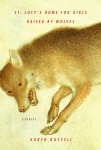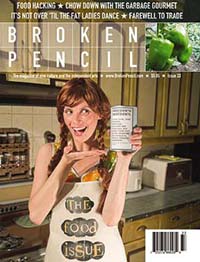Deer race across Ucross’s no hunting fields. Dipsy-doodling like left-wingers up over the blue line, they out manoeuvre the slow moving cattle traffic. Yesterday a family settled in to graze the field behind the Depot – a doe, two fawns and a buck. The two fawns move, mirror images of each other, grazing chimerical in the fawn coloured grass [1]. I’m a little worried about the buck. His is the first set of antlers I’ve seen walking around, as opposed to hanging from the walls of Buck’s Cabin and Trading Post. Now here’s a real live rack. Not such a big buck, maybe no prize at all, maybe not the stuff of hunting fiction legend, which I admit I’ve read perhaps a little too much of lately, but he’s able to leap four-foot fences in a single bound. I hope he’s faster than a speeding bullet.
[1] After a brief arm wrestle over who gets the dictionary today, Karen and I perused the illustrated American Heritage Dictionary of the English Language together for a while this morning. Staring at fawns all day you start to wonder if it’s just your imagination or are fawns fawn coloured. They are indeed. The colour is named after the deer. Fawn comes from the old French foun, young animal, which comes from the vulgar Latin, feto, offspring. Chimerical may seem like an excessive word, but how else to describe it? You’re working away, writing about driving down an ancient Roman road, or trying to channel the point of view of a young man just drafted to fight in Vietnam, or editing a story that you can’t remember writing though apparently the word document has been languishing in your computer for over two years, and for no reason at all you glance out the window and a fawn coloured fawn flits across the fawn coloured grass, and then another one, and then, as if he hears you watching, a youn buck lifts his antlered head.
chimerical: 1. created by or as if by a wildly fanciful imagination; highly improbably.
2. given to unrealistic fantasies; fanciful.
. . . . .

